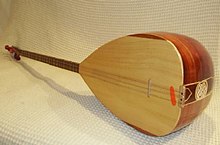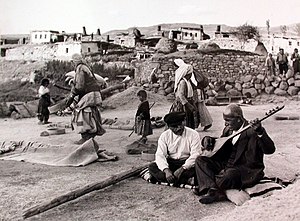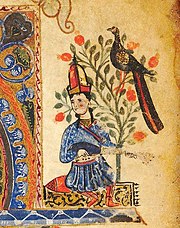| This article needs additional citations for verification. Please help improve this article by adding citations to reliable sources. Unsourced material may be challenged and removed. Find sources: "Bağlama" – news · newspapers · books · scholar · JSTOR (April 2021) (Learn how and when to remove this message) |
 Diffrerent sizes of bağlama: Cura (left) and Çöğür bağlama (right) Diffrerent sizes of bağlama: Cura (left) and Çöğür bağlama (right) | |
| String instrument | |
|---|---|
| Classification | |
| Related instruments | |
| Sound sample | |
|
| |
The bağlama or sâz/ساز is a family of plucked string instruments and long-necked lutes used in Ottoman classical music, Kurdish music, and also Arabesque music, Azerbaijani music, Bosnian music (Sevdalinka), and Armenian music. It is played in several regions in the world such as Europe, Asia, Black Sea, Caucasus regions and many countries including Syria, Kurdistan Region of Iraq, Iran, Iraq and Bosnia and Herzegovina. It is commonly used by the ashiks.
Bağlama (pronounced [baːɫaˈma]) is derived from the Turkish word bağlamak meaning "to tie". Used notably in Azerbaijan, the alternative name in Kurdish also in Persian is , Saz (Persian: ساز, romanized: sâz, lit. 'sāz') means "musical instrument", derived from a Persian and Kurdish verb that means "to make, to compose".
According to The New Grove Dictionary of Music and Musicians, "the terms 'bağlama' and 'saz' are used somewhat interchangeably in Turkey. 'Saz' is generally used interchangeably with 'enstrüman' (instrument) and it is used to refer single or group of musical instruments like 'üflemeli sazlar' (wind instruments).
Like the Western lute and the Middle-Eastern oud, bağlama has a deep round back, with a much longer neck. It can be played with a plectrum or with a fingerpicking style known as şelpe.
In the music of Greece the name baglamas (Greek: μπαγλαμάς) is given to a treble bouzouki, a related instrument. The Turkish settlement of Anatolia from the late eleventh century onward saw the introduction of a two-string Iranian dutar that Turkmen people adopted which in turn was played in some areas of Turkey until recent times by the kurdish people.
Turkish bağlama
The most commonly used string folk instrument in Turkey, the bağlama has seven strings divided into courses of two, two and three. It can be tuned in various ways and takes different names according to region and size: Bağlama, Divan Sazı, Bozuk, Çöğür, Kopuz Irızva, Cura, Tambura, etc. The cura is the smallest member of the bağlama family: larger than the cura is the tambura, tuned an octave lower. The Divan sazı, the largest instrument in the family, is tuned one octave lower still.
A bağlama has three main parts, the bowl (called tekne), made from mulberry wood or juniper, beech, spruce or walnut, the spruce sound board (göğüs) and a neck of beech or juniper (sap). The tuning pegs are known as burgu (literally screw). Frets are tied to the sap with fishing line, which allows them to be adjusted. The bağlama is usually played with a mızrap or tezene (similar to a guitar pick) made from cherrywood bark or plastic. In some regions, it is played with the fingers in a style known as Şelpe or Şerpe.
There are also electric bağlamas, which can be connected to an amplifier. These can have either single or double pickups.
Azerbaijani saz
Traditionally the Azerbaijani saz has been a mainstay of ashiqs, minstrels who combine poetry, storytelling, dance and vocal/instrumental music into a performance art that's considered one of the symbols of Azerbaijani cultural, literary and musical identity.
Since 2009 the art of Azerbaijani Ashiqs has been inscribed on Unesco's Representative List of the Intangible Cultural Heritage of Humanity.
Kopuz and the bağlama

The bağlama is a synthesis of historical musical instruments in Central Asia and pre-Turkish Anatolia. It is partly descended from the Turkic komuz. The kopuz, or komuz, differs from the bağlama in that it has a leather-covered body and two or three strings made of sheep gut, wolf gut, or horsehair. It is played with the fingers rather than a plectrum and has a fingerboard without frets. Bağlama literally translates as "something that is tied up", probably a reference to the tied-on frets of the instrument. The word bağlama is first used in 18th-century texts. The French traveler Jean Benjamin de Laborde, who visited Turkey during that century, recorded that "the bağlama or tambura is in form exactly like the cogur, but smaller." The Çoğur/Çöğur was in many ways a transitional Instrument between old Komuz and new Bağlama style and has a body shape similar to the Instrument called panduri in Georgia.
According to the historian Hammer, metal strings were first used on a type of komuz with a long fingerboard known as the kolca kopuz in 15th-century Anatolia. This was the first step in the emergence of the çöğür (cogur), a transitional instrument between the kopuz and the bağlama. According to 17th-century writer Evliya Çelebi, the çöğür was first made in the city of Kütahya in western Turkey. To take the strain of the metal strings the leather body was replaced with wood, the fingerboard was lengthened and frets were introduced. Instead of five hair strings there were now twelve metal strings arranged in four groups of three. Today, the çöğür is smaller than a medium-size bağlama. Çöğür is also used to refer medium sized short necked bağlama (kısa sap bağlama).
Bağlama (Saz) family
| Name | Freq. (low) | Body Length | Bowl Radius | Neck Length | String Length | Description |
|---|---|---|---|---|---|---|
| Cura | 586 Hz D | 22.5 cm | 13.5 cm | 30 cm | 48 cm | The smallest. |
| Üçtelli saz | Three wire strings, single course. | |||||
| Çöğür saz | The Cogur. | |||||
| Tambura | 293 Hz D | 38 cm | 22.8 cm | 52 cm | 80 cm | See Tanbur. |
| Bağlama | 220 Hz A | 44.5 cm | 24.9 cm | 55 cm | 88 cm | The most common. |
| Bozuk saz | G | See bouzouki. | ||||
| Meydan sazı | 110 Hz A | 52.5 cm | 31.5 cm | 70 cm | 112 cm | |
| Aşik sazı | ||||||
| Divan sazı | 146 Hz D | 49 cm | 29.4 cm | 65 cm | 104 cm | |
| Bas sazı | Bass version. |
Bağlama tunings
There are three string groups, or courses, on the bağlama, with strings double or tripled. These string groups can be tuned in a variety of ways, known as düzen (literally, "order"). For the bağlama düzeni, the most common tuning, the courses are tuned from top downward, A-G-D. Some other düzens are Kara Düzen (C-G-D), Misket Düzeni (A-D-F#), Müstezat (A-D-F), Abdal Düzeni, and Rast Düzeni.
- Bağlama düzeni (La, Sol, Re) (A, G, D)
- Bozuk düzen, kara düzen (Sol, Re, La) (G, D, A)
- Misket düzeni (Fa#, Re, La) (F#, D, A)
- Fa müstezat düzeni (Fa, Re, La) (F, D, A)
- Abdal düzeni (La, La, Sol) (A, A, G)
- Zurna düzeni (Re, Re, La) (D, D, A)
- Do müstezat düzeni (Sol, Do, La) (G, C, A)
- Aşık düzeni (La (bottom string set), Re (middle string set), Mi (Top string set) (A, D, E)
Bağlama Scale
The musical scale of the bağlama differs from that of many western instruments – such as the guitar – in that it features ratios that are close to quarter tones. The traditional ratios for bağlama frets are listed by Yalçın Tura:
- Fret 1: 18/17
- Fret 2: 12/11
- Fret 3: 9/8
- Fret 4: 81/68
- Fret 5: 27/22
- Fret 6: 81/64
- Fret 7: 4/3
- Fret 8: 24/17
- Fret 9: 16/11
- Fret 10: 3/2
- Fret 11: 27/17
- Fret 12: 18/11
- Fret 13: 27/16
- Fret 14: 16/9
- Fret 15: 32/17
- Fret 16: 64/33
- Fret 17: 2/1
However, as confirmed by Okan Öztürk, instrument makers now often set frets on the bağlama with the aid of fret calculators and tuners based on the 24-tone equal temperament.
Notable performers


- Pir Sultan Abdal (1502–1566)
- Karacaoğlan (1579–1639)
- Dadaloğlu (1723–1789)
- Gevheri (1672–1735)
- Aşık Veysel (1894–1973)
- Arif Sag (1945 – )
- Muharrem Ertaş (1913–1984)
- Neşet Ertaş (1938–2012)
- Hüseyin Altın (1958–2016)
- Ali Özütemiz (1968–2011)
- Esat Kabaklı
- Emrah
- Kör Ahmet (1933–2016)
- Uğur Işılak
- Sinan Özen
- Mustafa Yıldızdoğan
- Hilmi Şahballı
- Azer Bülbül (1969–2012)
- Orhan Ölmez
- Onur Şan
- Osman Öztunç
- Aşık Mahzuni Şerif (1940–2002)
- Mahsun Kırmızıgül
- Fatih Kısaparmak
- Ozan Arif (1949–2019)
- Müslüm Gürses (1953–2013)
- Orhan Gencebay
- İsmail Türüt
- Erkan Ocaklı (1949–2008)
- İbrahim Erkal (1967–2017)
- Ferdi Tayfur
- Burhan Çaçan (1960–2023)
- Nuray Hafiftaş (1964–2018)
- Hašim Muharemović (1937–2012)
- Selim Salihović (1910–1988)
- Muhamed Mešanović Hamić (1931–1978)
- Cem Yildiz
- Muhlis Berberoğlu
See also

- Alevism
- Art of Azerbaijani Ashiqs
- Baglamas
- Bouzouki (Greece)
- Buzuq (Lebanon & Syria)
- Çiftelia
- Dombra
- Dutar
- Innaby, Azerbaijani dance
- Komuz
- Music of Turkey
- Sallaneh (lute)
- Šargija
- Setar
- Tambura (instrument)
- Tanbur
References
- "ATLAS of Plucked Instruments – Middle East". ATLAS of Plucked Instruments. Retrieved February 27, 2013.
- Scheherezade Qassim Hassan; Morris, R. Conway; Baily, John; During, Jean (2001). "Tanbūr". In Sadie, Stanley; Tyrrell, John (eds.). The New Grove Dictionary of Music and Musicians. Vol. xxv (2nd ed.). London: Macmillan. pp. 61–62.
- Yalçın Tura, "Türk Musikisinin Mes'eleleri". İstanbul, Pan Yayıncılık, 1988, ISBN 975-7652-02-4. See page 159.
- Zhudki, Aleh. "O. ÖZTÜRK: FROM SEVENTEEN TO TWENTY-FOUR: INSTRUMENTS OF BAĞLAMA FAMILY AND TRADITIONAL TONE SYSTEM". academia.edu. Retrieved 2 April 2018.
- "Bağlamada Perde Ayarları". www.turkuler.com. Retrieved 2 April 2018.
External links
| Azerbaijani musical instruments | |
|---|---|
| String instruments | |
| Woodwind instruments | |
| Percussion instruments |
|
| Possibly extinct | |
| See also | |
| Armenian musical instruments | |
|---|---|
| Percussion instruments | |
| Wind instruments | |
| String instruments | |
| See also | |
| Iranian musical instruments | |||||||||
|---|---|---|---|---|---|---|---|---|---|
| Stringed (Sāzhāy-e Zehī) |
| ||||||||
| Woodwind (Sāzhāy-e Bādī) |
| ||||||||
| Brass |
| ||||||||
| Percussion (Sāzhāy-e Kūbeheyī/Zarbī) |
| ||||||||
| Afghan traditional music Azerbaijani traditional music Kurdish traditional music Persian traditional music Tajik traditional music | |||||||||
| Macedonian musical instruments | |
|---|---|
| String instruments | |
| Aerophones | |
| Percussion instruments | |
| Turkish musical instruments | |
|---|---|
| String instruments |
|
| Woodwind instruments | |
| Percussion instruments | |
| See also | |